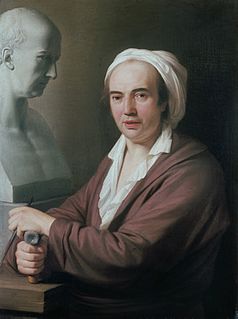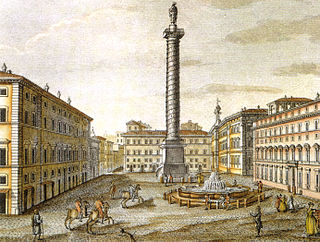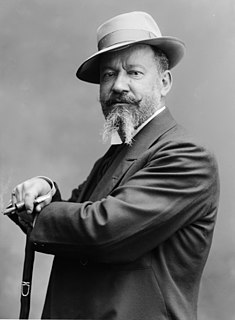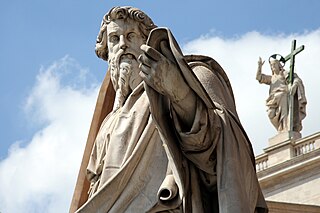Related Research Articles

Antonio Canova was an Italian Neoclassical sculptor, famous for his marble sculptures. Often regarded as the greatest of the Neoclassical artists, his sculpture was inspired by the Baroque and the classical revival, and has been characterised as having avoided the melodramatics of the former, and the cold artificiality of the latter.

Barletta is a city, comune of Apulia, in south eastern Italy. Barletta is the capoluogo, together with Andria and Trani, of the Province of Barletta-Andria-Trani. It has a population of around 94,700 citizens.

Lorenzo Bartolini was an Italian sculptor who infused his neoclassicism with a strain of sentimental piety and naturalistic detail, while he drew inspiration from the sculpture of the Florentine Renaissance rather than the overpowering influence of Antonio Canova that circumscribed his Florentine contemporaries.

Christopher Hewetson (c.1737–1798) was a neoclassical sculptor of portrait busts. Born in Ireland, he was active in Rome.

Piazza del Popolo is a large urban square in Rome. The name in modern Italian literally means "People's Square", but historically it derives from the poplars after which the church of Santa Maria del Popolo, in the northeast corner of the piazza, takes its name.

Piazza Colonna is a piazza at the center of the Rione of Colonna in the historic heart of Rome, Italy. It is named for the marble Column of Marcus Aurelius, which has stood there since AD 193. The bronze statue of Saint Paul that crowns the column was placed in 1589, by order of Pope Sixtus V. The Roman Via Lata runs through the piazza's eastern end, from south to north.

Filippo Barigioni (1690–1753) was an Italian sculptor and architect working in the Late Baroque tradition.

Psyche Revived by Cupid's Kiss is a sculpture by Italian artist Antonio Canova first commissioned in 1787 by Colonel John Campbell. It is regarded as a masterpiece of Neoclassical sculpture, but shows the mythological lovers at a moment of great emotion, characteristic of the emerging movement of Romanticism. It represents the god Cupid in the height of love and tenderness, immediately after awakening the lifeless Psyche with a kiss. The story of Cupid and Psyche is taken from Lucius Apuleius' Latin novel The Golden Ass, and was popular in art.

The fountain in the Piazza Colonna is a fountain in Rome, Italy, designed by the architect Giacomo Della Porta and constructed by the Fiesole sculptor Rocco Rossi between 1575 and 1577.

Amedeo Modigliani

Giuseppe Mazzuoli was an Italian sculptor working in Rome in the Bernini-derived Baroque style. He produced many highly accomplished sculptures of up to monumental scale but was never a leading figure in the Roman art world.

Raffaello Romanelli was an Italian sculptor, born in Florence, Italy.
Michele Canova Iorfida is an Italian record producer, arranger, songwriter and engineer. Since 2003, Iorfida has been responsible for more than 18 million album sales worldwide. His work with artists including Jovanotti, Tiziano Ferro, and Giusy Ferreri has resulted in 7 Diamond, 15 Multi Platinum, and 10 Platinum FIMI certifications

Giovanni Ferrari detto Torretto was an Italian sculptor.

Giovanni Antonio Antolini was an Italian architect and writer.

Rinaldo Rinaldi was an Italian Sculptor.

Tommaso Solari was an Italian sculptor active in a Romantic-style.

Adamo Tadolini was an Italian sculptor. One of a family of sculptors, he studied in Rome with the neo-classical sculptor Antonio Canova and is linked to him in style.
Giuseppe Ducrot is an Italian sculptor and member of the Pontifical Academy of Fine Arts and Letters of the Virtuosi al Pantheon.

The Venus Italica is a marble sculpture commissioned by Napoléon Bonaparte and fashioned by Italian sculptor Antonio Canova. Canova finished the original work in 1802 and modelled two further variants which he completed in 1819. The work was to serve as a replacement for the Venus de Medici sculpture, a copy of an antique work by Cleomenes of Athens, which had been seized, taken to France and placed in the Louvre in 1802 by orders of Bonaparte. After Napoleon's abdication the Venus de Medici was returned to Italy on 27 December 1815 and is since on display in the Room of Venus in the Galleria Palatina at the Palazzo Pitti in Florence.
References
- Touring Club Italiano (TCI), Roma e dintorni (1965) pp 181, 356, 423.